Study on the Evolution Law of Deep Rock Cracks and the Mechanism of Graded Gradient Support
Abstract
1. Introduction
2. Study on Evolution Characteristics of Roadway Surrounding Rock Fissure
3. Study on Graded Control Mechanism of Gradient Support
3.1. Graded Control Mechanism of Gradient Support
3.2. Key Ideas of Graded Control for Gradient Support
3.3. Hierarchical Control Principle Model of Gradient Support
4. Discussion on the Injectivity of Reinforcement Materials
4.1. Traditional Reinforcement Material
4.2. Graded Control Technology of Gradient Support
5. Conclusions
- (1)
- After roadway excavation, the stress of the deep surrounding rock is redistributed. Along the radial direction of the roadway, it is divided into stress reduction zone, stress increase zone, and original rock stress zone. According to the permeability characteristics, it can be divided into complete seepage zone, seepage shield zone, and proto-rock seepage zone.
- (2)
- When the crack opening degree of the surrounding rock meets certain conditions, slurries can permeate into the crack. However, the deep surrounding rock cracks are dense and wide near the roadway, while the deep ones are sparse and narrow. Changing the particle size of the material can improve the grouting ability. If the difference between the particle size of the grouting material and the crack is greater than 3 times, the grouting cannot be injected into the crack, and the bridge state will gradually appear at the crack mouth, greatly reducing the reinforcement effect.
- (3)
- The equivalent graded gradient support is proposed, and the mechanical model of gradient support is established. The gradient graded support is adopted to achieve the integration of the surrounding rock and provide support to the broken zone and to the plastic zone. Stratified control of load uniformity ensures that the strength of the surrounding rock in the broken zone and the plastic zone is restored to the initial stress strength or close to the state of the surrounding rock in the elastic zone, that is, the implementation of the original σc1 < σc2 < σc3 transforms into σ*c1 ≈ σ*c2 ≈ σ*c3.
Author Contributions
Funding
Institutional Review Board Statement
Informed Consent Statement
Data Availability Statement
Conflicts of Interest
References
- Bai, E.; Guo, W.; Tan, Y. Negative externalities of high intensity mining and disaster prevention technology in China. Bull. Eng. Geol. Environ. 2019, 78, 5219–5235. [Google Scholar] [CrossRef]
- Huang, Q.; He, W. Research on overburden movement characteristics of large mining height working face in shallow buried thin bedrock. Energies 2019, 12, 4208. [Google Scholar] [CrossRef]
- He, M.C.; Xie, H.P.; Peng, S.P.; Jiang, Y.D. Study on rock mechanics in deep mining engineering. Chin. J. Rock Mech. Eng. 2005, 24, 2803–2813. [Google Scholar]
- Chen, J.; Zhao, J.; Zhang, S.; Zhang, Y.; Yang, F.; Li, M. An experimental and analytical research on the evolution of mining cracks in deep floor rock mass. Pure Appl. Geophys. 2020, 177, 5325. [Google Scholar] [CrossRef]
- Yin, Q.; Wu, J.Y.; Jiang, Z.; Zhu, C.; Su, H.; Jing, H.; Gu, X. Investigating the effect of water quenching cycles on mechanical behaviors for granites after conventional triaxial compression. Geomech. Geophys. Geo-Energy Geo-Resour. 2022, 8, 77. [Google Scholar] [CrossRef]
- Liu, C.; Yang, Z.; Gong, P.; Wang, K.; Zhang, X.; Zhang, J.; Li, Y. Accident analysis in relation to main roof structure when longwall face advances toward a roadway: A case study. Adv. Civ. Eng. 2018, 2018, 3810315. [Google Scholar] [CrossRef]
- Yu, W.; Pan, B.; Zhang, F.; Yao, S.; Liu, F. Deformation characteristics and determination of optimum supporting time of alteration rock mass in deep mine. KSCE J. Civ. Eng. 2019, 23, 4921–4932. [Google Scholar] [CrossRef]
- Ren, D.Z.; Wang, X.Z.; Kou, Z.H.; Wang, S.; Wang, H.; Wang, X.; Tang, Y.; Jiao, Z.; Zhou, D.; Zhang, R. Feasibility evaluation of CO2 EOR and storage in tight oil reservoirs: A demonstration project in the Ordos Basin. Fuel 2023, 331, 125652. [Google Scholar] [CrossRef]
- Wang, Y.; Zhu, C.; He, M.C.; Wang, X.; Le, H.L. Macro-meso dynamic fracture behaviors of Xinjiang marble exposed to freeze thaw and frequent impact disturbance loads: A lab-scale testing. Geomech. Geophys. Geo-Energy Geo-Resour. 2022, 8, 154. [Google Scholar] [CrossRef]
- He, M.; Sui, Q.; Li, M.; Wang, Z.; Tao, Z. Compensation Excavation Method Control for Large Deformation Disaster of Mountain Soft Rock Tunnel. Int. J. Min. Sci. Technol. 2022, 5, 951–963. [Google Scholar] [CrossRef]
- Alsayed, M.I. Utilising the Hoek triaxial cell for multriaxial testing of hollow rock cylinders. Int. J. Rock Mech. Min. Sci. 2002, 39, 355–366. [Google Scholar] [CrossRef]
- Kulatilake, P.H.S.W.; Park, J.; Malama, B. A new rockmass failure criterion for biaxial loading conditions. Geotechnol. Geol. Eng. 2006, 24, 871–888. [Google Scholar] [CrossRef]
- Unver, B.; Yasitli, N.E. Modelling of strata movement with a special reference to caving mechanism in thick seam coal mining. Int. J. Coal Geol. 2006, 66, 227–252. [Google Scholar] [CrossRef]
- Ju, Y.; Wang, Y.; Su, C.; Zhang, D.; Ren, Z. Numerical analysis of the dynamic evolution of mining-induced stresses and fractures in multilayered rock strata using continuum based discrete element methods. Int. J. Rock Mech. Min. Sci. 2019, 113, 191–210. [Google Scholar] [CrossRef]
- Duan, B.; Xia, H.; Yang, X. Impacts of bench blasting vibration on the stability of the surrounding rock masses of roadways. Tunnel. Undergr. Space Technol. 2018, 71, 605–622. [Google Scholar] [CrossRef]
- Yu, W.; Liu, F. Stability of close chambers surrounding rock in deep and comprehensive control technology. Adv. Civ. Eng. 2018, 2018, 6275941. [Google Scholar] [CrossRef]
- Liu, C. Research on deep-buried roadway surrounding rock stability and control technology. Geotech. Geol. Eng. 2018, 36, 3871–3878. [Google Scholar] [CrossRef]
- Bao, Y.D.; Chen, J.P.; Su, L.J.; Zhang, W.; Zhan, J. A novel numerical approach for rock slide blocking river based on the CEFDEM model: A case study from the Samaoding paleolandslide blocking river event. Eng. Geol. 2023, 312, 106949. [Google Scholar] [CrossRef]
- Kang, H.P.; Wang, G.F.; Jiang, P.F.; Wang, J.C.; Zhang, N.; Jing, H.W.; Huang, B.X.; Yang, B.G.; Guan, X.M.; Wang, Z.G. Conception for strata control and intelligent mining technology in deep coal mines with depth more than 1000 m. J. China Coal Soc. 2018, 43, 1789–1800. [Google Scholar]
- Xie, H.; Peng, S.; He, M. Basic Theory and Engineering Practice in Deep Mining; Science Press: Beijing, China, 2005; pp. 1–35. [Google Scholar]
- Nikbakhtan, B.; Osanloo, M. Effect of grout pressure and grout flow on soil physical and mechanical properties injet grouting operations. Int. J. Rock Mech. Min. Sci. 2009, 46, 498–505. [Google Scholar] [CrossRef]
- Hong, Z.; Zuo, J.; Zhang, Z.; Liu, C.; Liu, L.; Liu, H.Y. Effects of nano-clay on the mechanical and microstructural properties of cement based grouting material in sodium chloride solution. Constr. Build. Mater. 2020, 245, 118420. [Google Scholar] [CrossRef]
- Varol, A.; Dalgic, S. Grouting applications in the Istanbul metro, Turkey. Tunnel. Undergr. Space Technol. 2006, 21, 602–612. [Google Scholar] [CrossRef]
- Wang, H.; Li, H.; Tang, L.; Ren, X.; Meng, Q.; Zhu, C. Fracture of two three-dimensional parallel internal cracks in brittle solid under ultrasonic fracturing. J. Rock Mech. Geotech. Eng. 2022, 14, 757–769. [Google Scholar] [CrossRef]
- Zhang, N.; Xu, X.L.; Li, G.C. Fissuere-evolving laws of surrounding rock mass of roadway and control of seepage disasters. Chin. J. Rock Mech. Eng. 2009, 28, 331–335. [Google Scholar] [CrossRef]
- Dong, F. Support Theory and Application Technology of Roadway Surrounding Rock Loose Zone; China Coal Industry Press: Beijing, China, 2001; pp. 20–45. [Google Scholar]
- Zuo, J.P.; Hong, Z.J.; Yu, M.L.; Liu, H.Y.; Wang, Z.B. Research on gradient support model and classification control of broken surrounding rock. J. China Univ. Min. Technol. 2022, 51, 221–231. [Google Scholar]
- Zhang, Z. Study on the Mechanism of Grouting Reinforcement of Weak Medium Filling Cracks. Ph.D. Dissertation, Shangdong University, Jinan, China, 2015. [Google Scholar]
- Guo, Y.; Zhang, B.L.; Zheng, X.G.; Zhou, W.; Wei, X.L.; Zhu, D.X. Grouting reinforcement technology of superfine cement with wind oxidation zone based on time-varying rheological parameters of slurries. J. Min. Saf. Eng. 2019, 36, 339–344. [Google Scholar]
- Zuo, J.P.; Wei, X.; Wang, J.; Liu, D.J.; Cui, F. Investigation of failure mechanism and model for rocks in deep roadway under stress gradient effect. J. China Univ. Min. Technol. 2018, 47, 478–485. [Google Scholar]
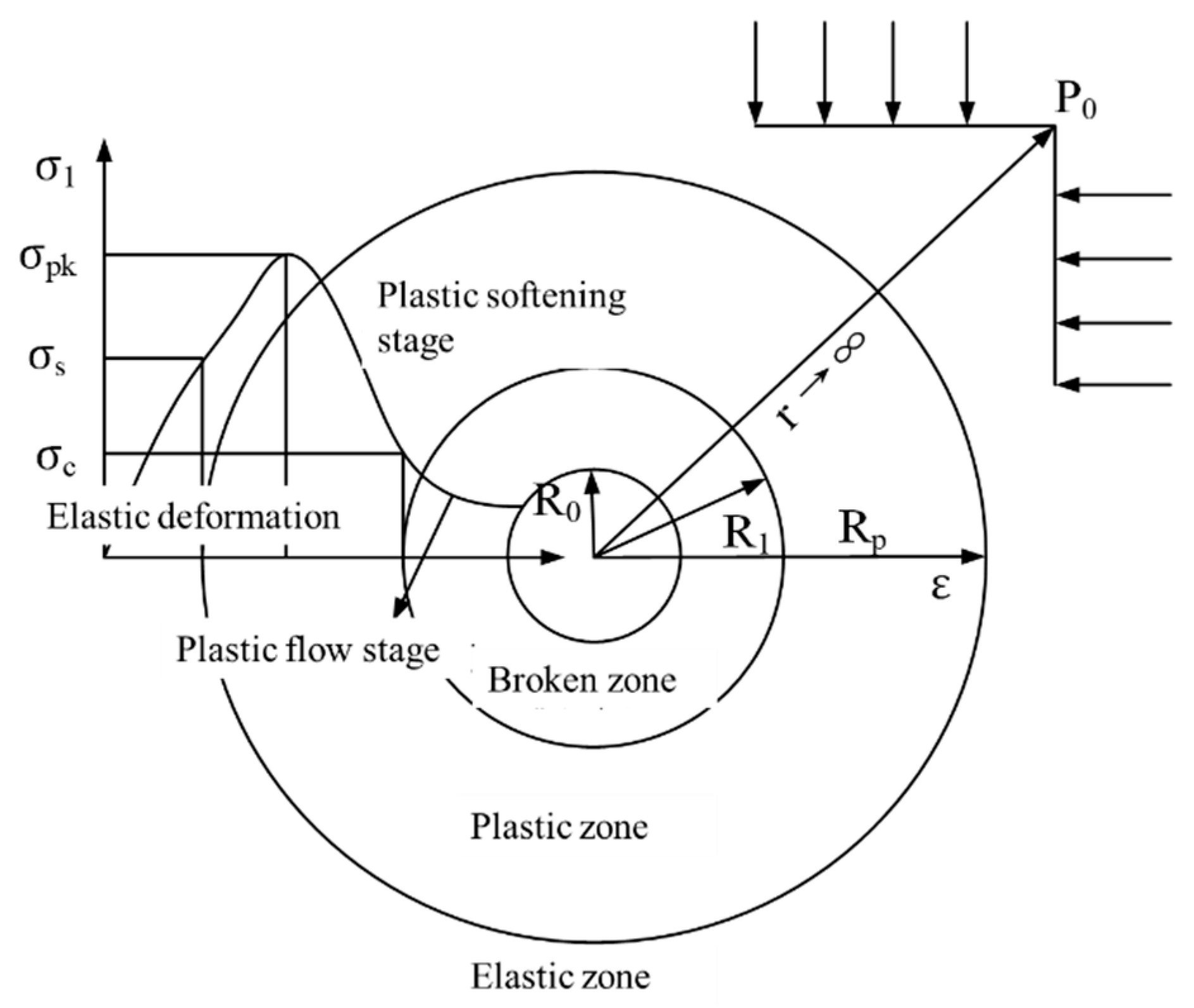
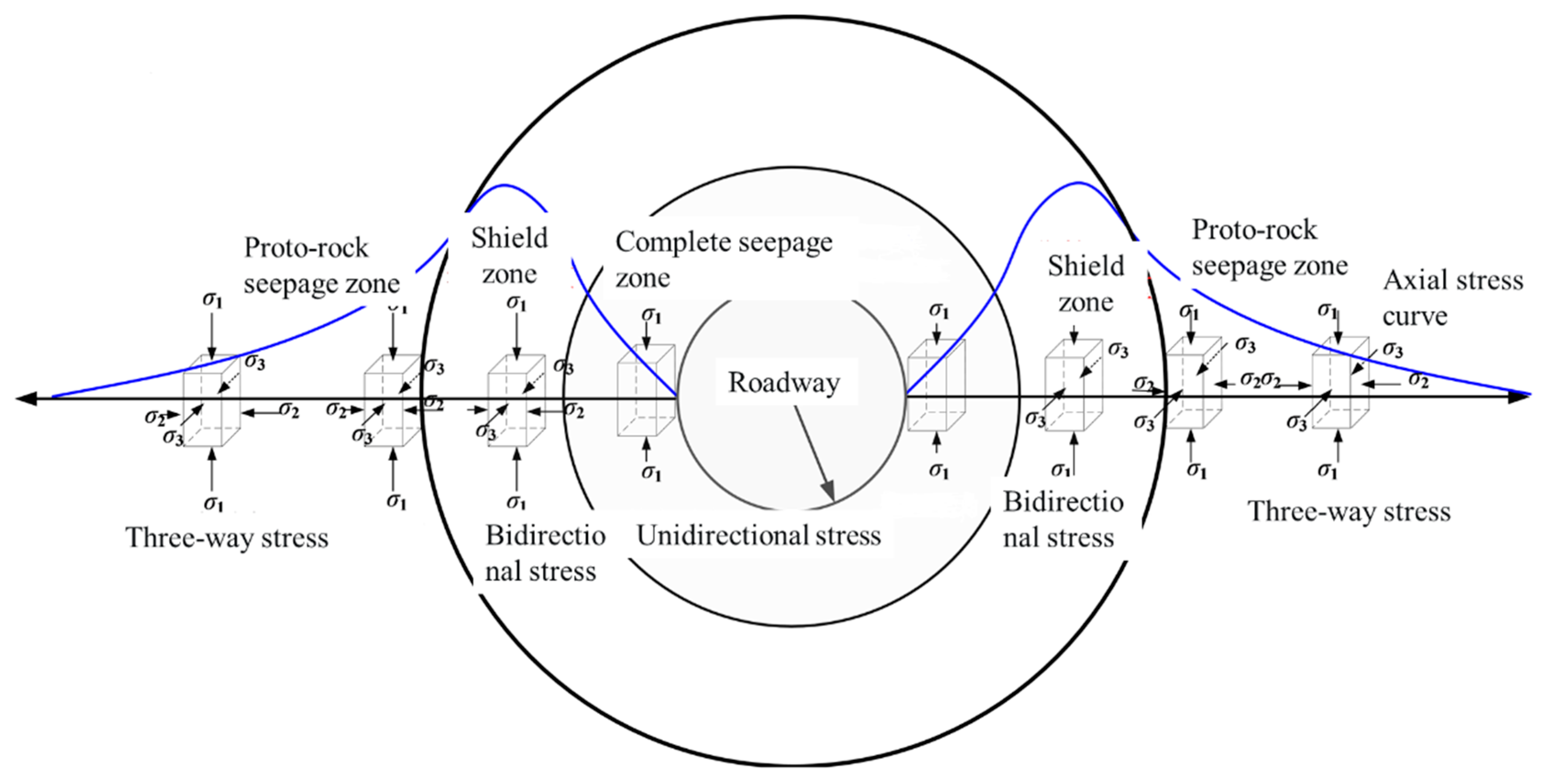

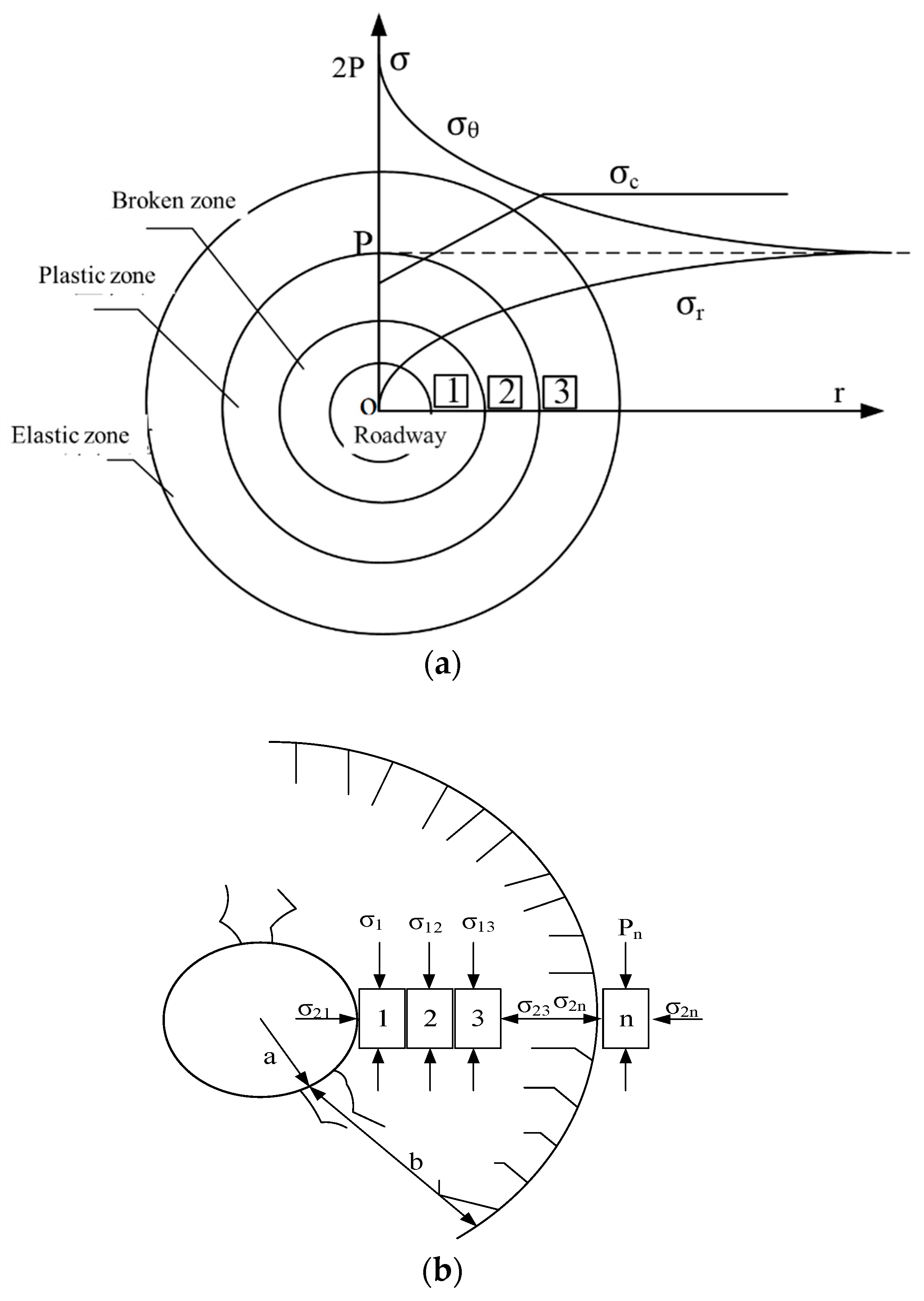
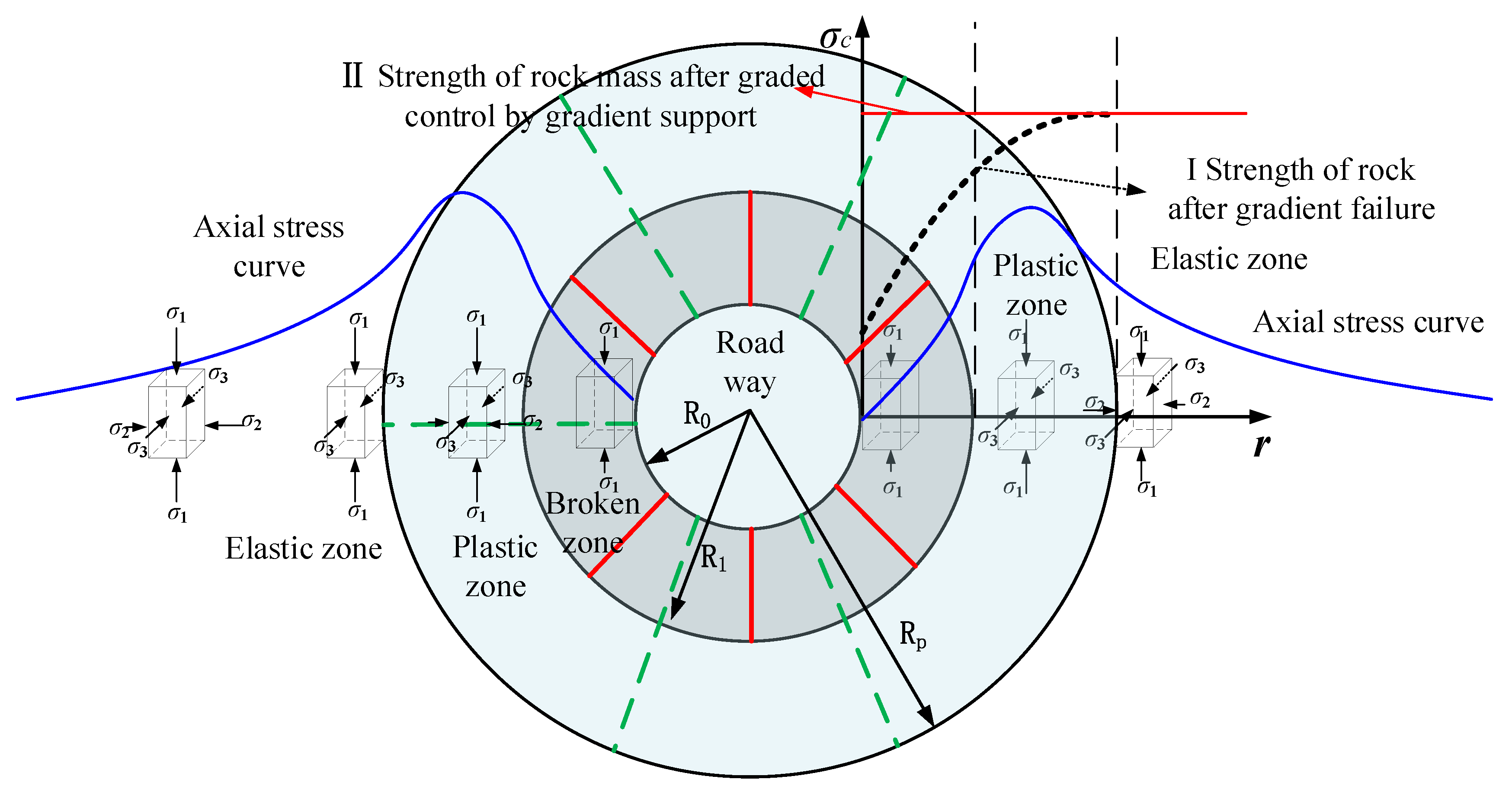
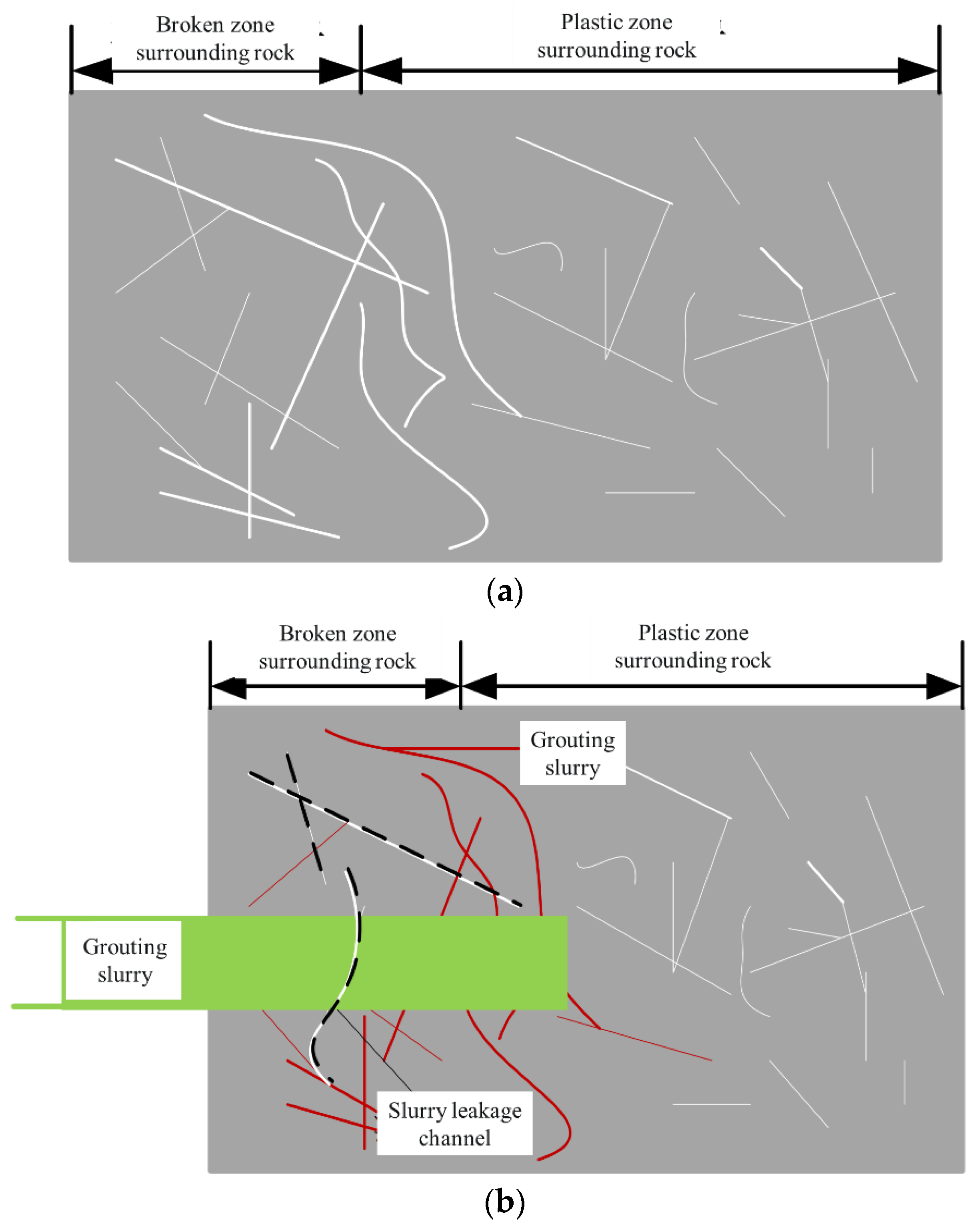
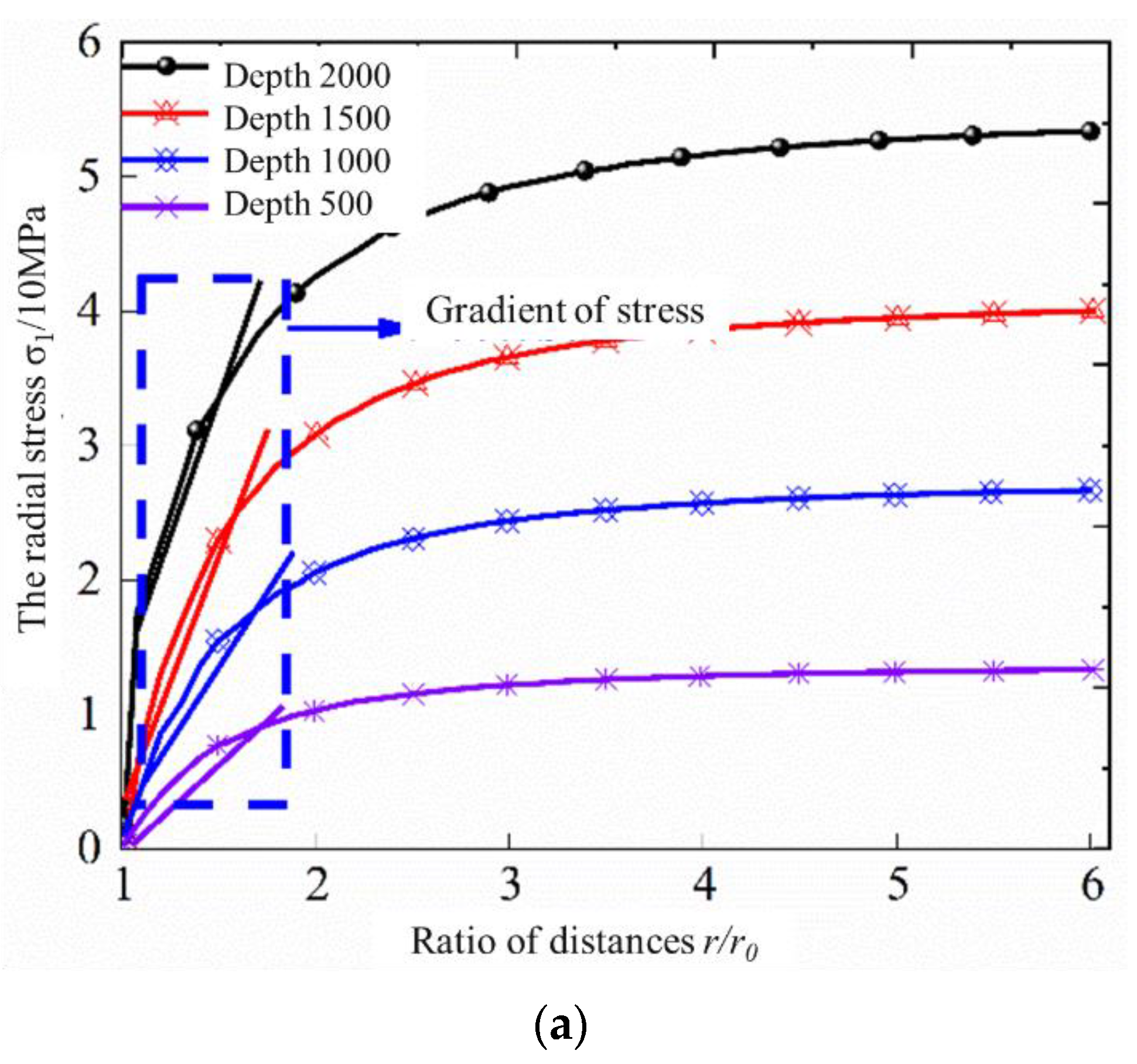

Disclaimer/Publisher’s Note: The statements, opinions and data contained in all publications are solely those of the individual author(s) and contributor(s) and not of MDPI and/or the editor(s). MDPI and/or the editor(s) disclaim responsibility for any injury to people or property resulting from any ideas, methods, instructions or products referred to in the content. |
© 2023 by the authors. Licensee MDPI, Basel, Switzerland. This article is an open access article distributed under the terms and conditions of the Creative Commons Attribution (CC BY) license (https://creativecommons.org/licenses/by/4.0/).
Share and Cite
Hong, Z.; Li, Z.; Du, F.; Cao, Z.; Zhu, C. Study on the Evolution Law of Deep Rock Cracks and the Mechanism of Graded Gradient Support. Energies 2023, 16, 1183. https://doi.org/10.3390/en16031183
Hong Z, Li Z, Du F, Cao Z, Zhu C. Study on the Evolution Law of Deep Rock Cracks and the Mechanism of Graded Gradient Support. Energies. 2023; 16(3):1183. https://doi.org/10.3390/en16031183
Chicago/Turabian StyleHong, Zijie, Zhenhua Li, Feng Du, Zhengzheng Cao, and Chun Zhu. 2023. "Study on the Evolution Law of Deep Rock Cracks and the Mechanism of Graded Gradient Support" Energies 16, no. 3: 1183. https://doi.org/10.3390/en16031183
APA StyleHong, Z., Li, Z., Du, F., Cao, Z., & Zhu, C. (2023). Study on the Evolution Law of Deep Rock Cracks and the Mechanism of Graded Gradient Support. Energies, 16(3), 1183. https://doi.org/10.3390/en16031183





